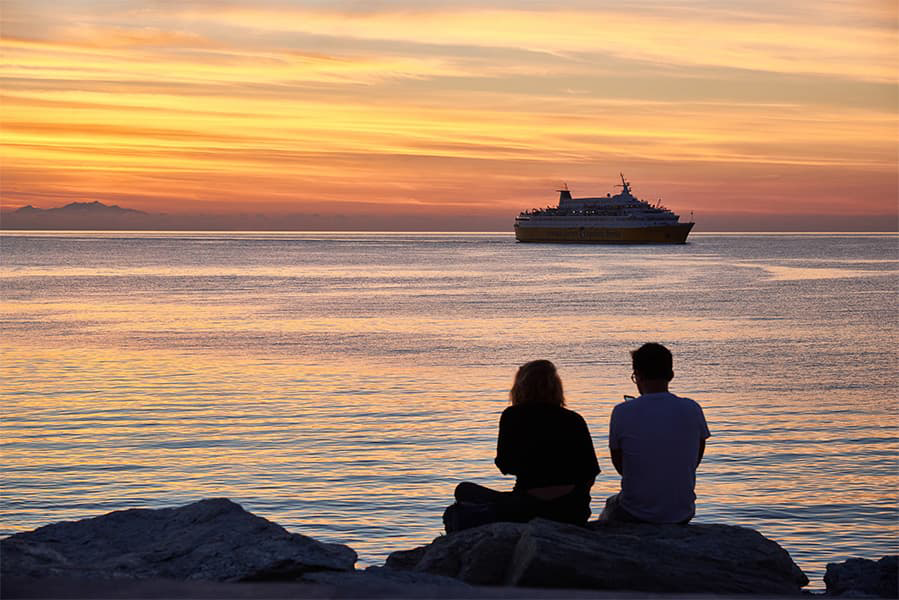Ferries from
Jersey to Guernsey
Ferries from
Jersey to Guernsey


Ferries from Jersey to Guernsey are available with 2 operators. The Jersey (St Helier) to Guernsey ferry is the main ferry route from Jersey to Guernsey. Sailing frequency can change throughout the year and often sailings increase during peak season.
Ferries from Jersey to Guernsey sail approximately once a week and are provided by Condor Ferries & Manche Iles Express.
Jersey to Guernsey ferry time ranges between 20 minutes and 43 hours 29 minutes depending on the ferry route, operator, and ship.
The fastest ferry from Jersey to Guernsey is in 20 minutes on the Jersey (St Helier) to Guernsey ferry with Manche Iles Express.
Yes, you can travel on a car ferry from Jersey to Guernsey with Condor Ferries.
The distance between Jersey and Guernsey is 34 miles (55km) and 30 nautical miles.
Jersey to Guernsey ferry prices can vary by route, operator, season, vehicle type and whether you are sailing on a high-speed ferry or conventional ferry.
The Jersey (St Helier) to Guernsey ferry ferry sails approximately once a week with a crossing time of 1 hour.
For the best ferry offers, we recommend booking in advance for the cheapest ferry prices and availability. Visit our special offers page to take advantage of all the latest ferry discounts.
Book and compare Jersey Guernsey ferry tickets, operators, timetables and prices using our Deal Finder.
| From | To | Average price | |
|---|---|---|---|
From Jersey (St Helier)Jersey |
To GuernseyGuernsey |
Average price£141.37 |
More routes than anyone else.

Compare fares, times & routes in one place.
Change plans easily with flexi tickets.

Book e-tickets & manage trips in-app.
Live ship tracking & real-time updates.

Top-rated customer support when you need it.
Jersey, the largest of the Channel Islands, is a British Crown dependency found just off the coast of Normandy in France. Reaching 9 miles long and 5 miles wide, it has a wealth of beaches and coastline activities on offer. The north and east coasts are scattered with rock pools ideal for children, whilst the south and west are lined by golden sandy beaches with bright blue waters worthy of the Mediterranean. However, Jersey is far more than just seaside fun, with plenty of fascinating landmarks and historical sites waiting to be explored including a ruinous 14th Century castle and Britain’s first concrete lighthouse. For a relatively small island, Jersey provides a wide range of ferry services from its port in St Helier on the south coast. You can sail to the other Channel Islands, northern France and the south coast of England, with a selection of ferry operators to choose from.
Guernsey is an island in the English Channel, just off the coast of Normandy and along with Jersey, and a number of smaller islands including Alderney, Sark, Herm, Jethou and Lihou, Guernsey forms part of the Channel Islands. With a total land area of seventy eight square kilometres, and a coastline of fifty kilometres, the landscape of Guernsey is dominated by its coastal features. Of its population of just sixty seven thousand, around a quarter live in St Peter Port, which is Guernsey’s capital, as well as its main port, providing a gateway to the island from France, neighbouring Jersey and England. The unique blend of French and English culture and the fact that both languages are spoken widely on the island make Guernsey a popular destination for visitors from the UK, France, and other parts of mainland Europe. Getting to Guernsey by ferry is a relatively painless experience with a choice of departure ports from both sides of the channel as well as inter-channel-island services from Jersey. Condor Ferries operate year round crossings from Portsmouth, Jersey and St Malo with both conventional and fast ferries, as well as a seasonal service from Poole. Manche Iles Express operates passenger only services to Guernsey from the French ports of Diélette, Carteret and Granville at various times throughout the year with some services travelling via Jersey. The island has an extensive bus route, which makes travelling around by public transport relatively straightforward. St Peter Port is well connected to the bus routes, meaning you can travel quickly and easily from your ferry to your final destination by bus. There are also a number of car hire options available at the ferry port and airport, for visitors who want the most flexible and self-contained transport option. The island does have some unusual traffic rules and a maximum speed limit of 35 mph across the entire island, which can take some visiting driver by surprise.